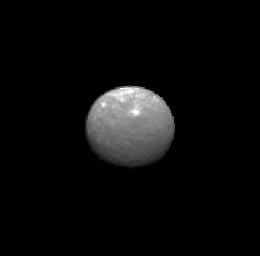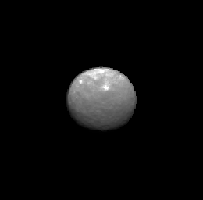
|
Animation of Ceres on Approach
- Click the image above for a larger view
 Movie Download Options
Movie Download Options- Full-Res JPEG (613 x 604) (8.0 kB)
- Full-Res TIFF (613 x 604) (370.8 kB)
Caption:

Click on the image for larger animation
This animation showcases a series of images NASA's Dawn spacecraft took on approach to Ceres on Feb. 4, 2015 at a distance of about 90,000 miles (145,000 kilometers) from the dwarf planet. These latest pictures of Ceres are the sharpest to date, at a resolution of 8.5 miles (14 kilometers) per pixel.
Background Info:
Dawn's mission to Vesta and Ceres is managed by the Jet Propulsion Laboratory for NASA's Science Mission Directorate in Washington. Dawn is a project of the directorate's Discovery Program, managed by NASA's Marshall Space Flight Center in Huntsville, Alabama. UCLA is responsible for overall Dawn mission science. Orbital ATK, Inc., of Dulles, Virginia, designed and built the spacecraft. JPL is managed for NASA by the California Institute of Technology in Pasadena. The framing cameras were provided by the Max Planck Institute for Solar System Research, Göttingen, Germany, with significant contributions by the German Aerospace Center (DLR) Institute of Planetary Research, Berlin, and in coordination with the Institute of Computer and Communication Network Engineering, Braunschweig. The visible and infrared mapping spectrometer was provided by the Italian Space Agency and the Italian National Institute for Astrophysics, built by Selex ES, and is managed and operated by the Italian Institute for Space Astrophysics and Planetology, Rome. The gamma ray and neutron detector was built by Los Alamos National Laboratory, New Mexico, and is operated by the Planetary Science Institute, Tucson, Arizona.
More information about Dawn is online at http://www.nasa.gov/dawn .
Cataloging Keywords:
| Name | Value | Additional Values |
|---|---|---|
| Target | 1 Ceres | |
| System | Main Belt | |
| Target Type | Asteroid | Dwarf Planet |
| Mission | Dawn | |
| Instrument Host | Dawn | |
| Host Type | Orbiter | |
| Instrument | Framing Camera (FC) | |
| Detector | ||
| Extra Keywords | Grayscale, Infrared, Movie | |
| Acquisition Date | ||
| Release Date | 2015-02-04 | |
| Date in Caption | 2015-02-04 | |
| Image Credit | NASA/JPL-Caltech/UCLA/MPS/DLR/IDA/PSI | |
| Source | photojournal.jpl.nasa.gov/catalog/PIA19182 | |
| Identifier | PIA19182 | |
